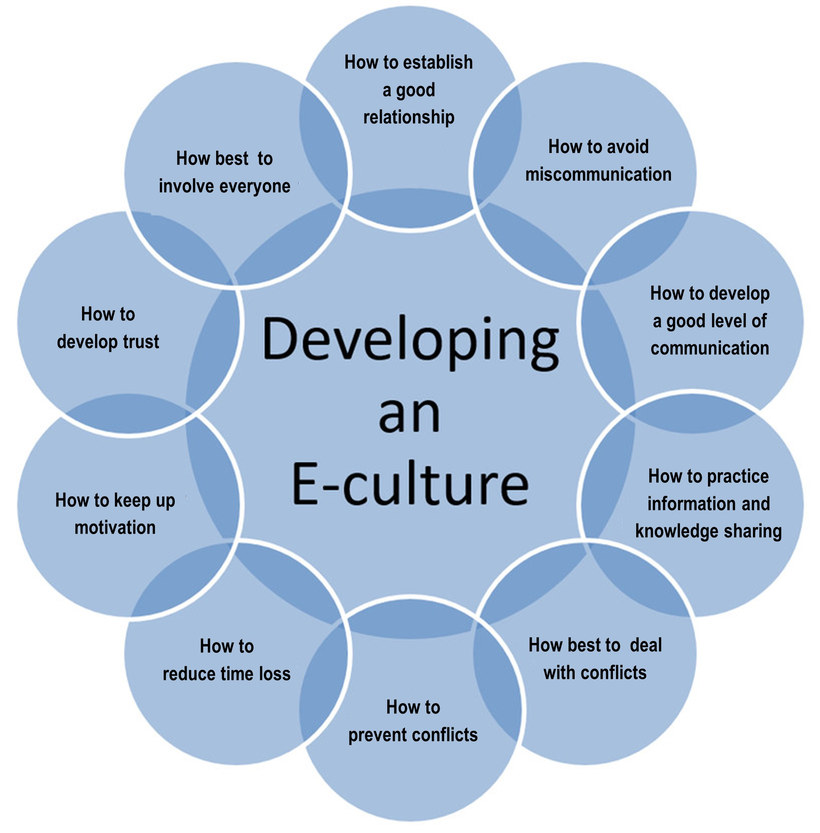When we talk about negotiating culture or negotiated interculturality, we refer to the synchronisation of incompatible routines of interaction. The aim is to develop an e-culture which is shared by all team members and supports team performance and team satisfaction. Negotiation as such involves co-creation and the process of sense-making or generating common meaning. This starts with the analysis of domains that require negotiation. Subsequently, cultural attributes are modified, recombined, or adapted. The following is an illustration of such a process:

Source: Based on Brannen, Mary Yoko & Jane E. Salk (2000, p. 457)
Figure by Julia Flitta (www.julia-flitta.com)
It shows actors coming together, bringing with them their work attitudes, patterns and processes as well as communication styles. In the process of team development, they need to assess which contextual factors are relevant and the degree of influence each one exerts . Contextual factors could be, for example, the organisational frameworks in which both the team and the individual members operate. Here we might expect to observe power and dependency issues. But contextual issues can also include areas such as family commitment or limited access to the internet. The process of team development then, is tied up with the notion of sense-making and meaning creation. We therefore need to focus on shared meanings. Examples of this could be the meaning and significance attached to deadlines or meetings. Finally, the goal and the vision, in other words the ‘what do we want to achieve together?’, needs to be clarified, and this will in turn determine many of the issue domains. Once the issue domains are clear, the team can then negotiate its team culture. The arrow pointing towards and away from the team and its negotiated culture indicates the processual character of culture development.
The illustration below provides an overview of team challenges and thus domains that may need to be part of the negotiation process:

The outcome of the negotiation process is unpredictable, but generally speaking several options are possible:
- Divided labour, which refers to a high level of separation of work and individual work areas. A team very quickly decides to allocate work packages and divide responsibilities, with each team member working on their own.
- Complementing each other refers to pooling resources such as knowledge and skills, with the aim of achieving a better outcome through this combination.
- Adapting refers to the ability and willingness to adjust one’s own behaviour and accept different and new behavioural patterns or work approaches in accordance with the situation and the team’s goals.
- Finding a middle way or compromise refers to the outcome of a negotiation whereby all team members 'give in' to a certain degree. An example would be a team that decides to start a team meeting with a short ‘social get together’. This could be, for example, not as long as some team members would prefer, but also, through its brevity, would accommodate those who would rather focus directly on work-related issues.
- Novel ways of interacting or synergies refer to the constructive approach of searching for new and innovative ways of working together. It is different from complementary approaches because it focuses on the added value of teamwork and the creation of something new through a combining process. Novel outcomes can develop when social interactions among team members trigger new interpretations and products, which the individual team members on their own would never have envisaged.

Source: Cartoon by Jörg Plannerer
This approach is therefore also referred to as the development of synergies, acknowledging that the whole is greater than the sum of its parts, as the illustration indicates. It is therefore qualitatively different from the mere adding together all team members' contributions.
The following quote from an internship report illustrates an example of this kind of value creation:
"Another example where the international team added value was when we were all working together on one analysis. While I for example got too much into detail and lost a lot of the time because I wanted it to be perfect, my colleague reminded me of what we still have left to do and why we should not get lost in detail. First, I thought this was not the way to go because we were not taking into account all the information we had but in the end I learnt that it was good to have the overall idea and look at the overall numbers. The way my colleagues were working was quite interesting because they defined a result they wanted to have and then found a way to get that result while I tried to do everything step by step towards the best result possible. By using a mix of both approaches we got a very meaningful analysis in the end and our boss was very happy with the result."
What this quote highlights is the fact that value creation requires openness and time. It is therefore crucial that we set aside the time for this open-ended process to unfold.